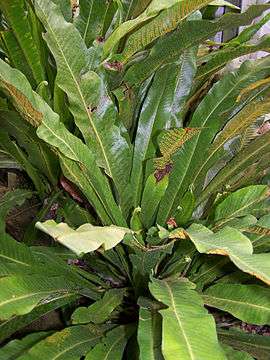Campyloneurum phyllitidis
| Campyloneurum phyllitidis | |
|---|---|
| | |
| Scientific classification | |
| Kingdom: | Plantae |
| Phylum: | Pteridophyta |
| Class: | Polypodiopsida / Pteridopsida (disputed) |
| Order: | Polypodiales |
| Family: | Polypodiaceae |
| Genus: | Campyloneurum |
| Species: | C. phyllitidis |
| Binomial name | |
| Campyloneurum phyllitidis (L.) C.Presl. | |
| Synonyms | |
|
Cyrtophlebium phyllitidis (L.) J. Sm. | |
Campyloneurum phyllitidis, commonly known as the long strap fern, is a species of fern in the Polypodiaceae family. [2]
Distribution
Campyloneurum phyllitidis is found in North, Central, and South America: from Florida, the Caribbean, and southeastern Mexico in the north; to tropical Peru and Brazil, and Paraguay in the south.
Other countries it is native to include the Southeastern United States, Cuba, Costa Rica, Bolivia, and Venezuela.[3] It is also present in Florida, Puerto Rico, Hawaii and the Virgin Islands.[4] The fern is common on Barro Colorado Island of Panama.[3]
Description
Campyloneurum phyllitidis is an epiphyte, growing on other plants; generally the fern is found growing in the canopies of trees.
It has a relatively large rhizome from which many fine rootlets covered in dark reddish-brown scales grow. Its leaves are simple in shape, hairless, 45–100 centimetres (18–39 in) long and 8–12 centimetres (3.1–4.7 in) wide.
The sori are round and small, occurring in on both sides of lateral veins of the leaves.[3]
It is known to grow as an epiphyte on Platypodium elegans, Ceiba pentandra, Tabebuia guayacan, Anacardium excelsum,[5] Socratea exorrhiza, Marila laxiflora and Perebea xanthochyma.[6]
Uses
Campyloneurum phyllitidis is cultivated as an ornamental plant, and is the most common species of Campyloneurum found in cultivation. The fern grows well in well-drained soil under medium levels of light. It needs to be protected from slugs and snails.[7]
Campyloneurum phyllitidis was grown in England during the Victorian era, when ferns were particularly popular (the phenomenon known as pteridomania). The fern was described by an author of the time, Shirley Hibberd, as being "very distinct" and that it formed a "striking object when grown well".[8]

See also
- Pteridophyta (ferns) of the Americas
References
- ↑ "Campyloneurum phyllitidis (L.) C. Presl". The Plant List. Retrieved 2011-02-20.
- ↑ Wunderlin, R. P.; B. F. Hansen (2008). "Atlas of Florida Vascular Plants - Campyloneurum phyllitidis". Institute for Systematic Botany, University of South Florida, Tampa. Retrieved 2010-02-20.
- 1 2 3 Thomas B. Croat (1978). Flora of Barro Colorado Island. Stanford University Press. pp. 103–. ISBN 978-0-8047-0950-7. Retrieved 20 February 2011.
- ↑ "Campyloneurum phyllitidis (L.) C. Presl". USDA Plants. Retrieved 2010-02-20.
- ↑ Jose Luis Andrade; Park S. Nobel (1997). "Microhabitats and Water Relations of Epiphytic Cacti and Ferns in a Lowland Neotropical Forest". Biotropica. 29 (3): 261–270. doi:10.2307/2389141. JSTOR 2389141.
- ↑ Laube, S.; Zotz, G. (2006). "Neither Host-specific nor Random: Vascular Epiphytes on Three Tree Species in a Panamanian Lowland Forest". Annals of Botany. 97 (6): 1103–14. doi:10.1093/aob/mcl067. PMC 2803392
 . PMID 16574691.
. PMID 16574691. - ↑ Barbara Joe Hoshizaki; Robbin Craig Moran (2001). Fern grower's manual. Timber Press. pp. 231–. ISBN 978-0-88192-495-4. Retrieved 20 February 2011.
- ↑ Shirley Hibberd (1869). The fern garden: how to make, keep, and enjoy it ; or, Fern culture made easy. Groombridge and Sons. pp. 107–. Retrieved 20 February 2011.